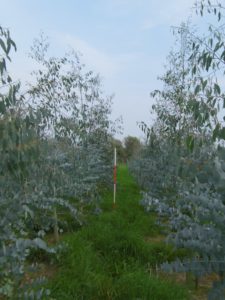Planting Eucalyptus? Read our planting guide first
It’s possible to plant Eucalyptus all over the British Isles but you need to make the right choice of species and plant according to best silvicultural practice. Many early trials failed as a limited range of frost susceptible species were used. However, the Eucalyptus genus is very diverse with many trees thriving in high altitudes in their native Australia (e.g. Blue Mountains and Central Tasmania) so there are many that can tolerate frost, exposure and wet sites. We sell 17 species cover all types including high yielding lowland species to more “bulletproof” species that are probably as tolerant to extremes as any native tree.
There are two main constraints to planting Eucalypts widely in UK:
- Low temperature –
- the most important factor is the duration of cold temperatures (for instance prolonged cold snaps of over two weeks) and
- Out of season radiation frosts – these are not generally common within oceanic/low altitude sites
- Adequate soil moisture
- Water is the carbon building block for wood/cellulose
- Although Eucalypts tend to be more water efficient and productive than other trees they still need adequate supplies.
For planting Eucalypts, it is important that care is taken to:
- Avoid frost hollows
- Avoid waterlogged sites
- Good silvicultural planning is required to match the origin species and provenance to the
- Site latitude
- Site altitude
- Broad climatic character
We recommend using the Forestry Commission’s Ecological Site Classification Decision Support System as a guide. However, please note that this only covers two Eucalyptus species – (E. gunnii which is frost tolerant and E. nitens which is more frost susceptible). If in any doubt please provide us with details of your site and conditions we will make recommendations. If you are planting at scale it makes sense to have a site visit so we can give expert advice on the ground.
In establishing a Eucalyptus plantation customary silvicultural practices needs to be adhered to for the trees to establish successfully and thrive. This includes:
- Pre-plant site preparation
- Clear ground for planting by spray/mechanical means
- Mound to give a clear planting area
- Ripping soil to minimise compaction
-
Species/provenance selection
- Appropriate spacing (see below)
- Make slightly bigger hole than the plug plant (a bulb planter is useful for this), add some top soil or compost and then make sure that all the plug is submerged
- Use of treeguards to give some protection and prevent damage from herbivores
- Planting through membrane or use of mulch mats recommended for micro plantations (< 300 trees)
- Post plant weeding is necessary to reduce competition prior to canopy closure
- Planning for SRF initial harvesting operation from 4-5 years of age
For more information on basic silvicultural practices we recommend reading Cultivation of lowland sites for new woodland establishment.
Spacing
For long rotation forestry involving Eucalypts we would recommend a stocking rate of 1,666 per hectare (3 m x 2 m).
For short rotation forestry (SRF) you should be looking at closer spacings such as:
- 2,000 plants per hectare (2.5 m by 2 m)
- 2,500 plants per hectare (2 m x 2 m)
We suggest going with the closer spacings in more exposed conditions. When smaller numbers of trees are planted it is better for the trees to be planted in tight groups leaving vistas, or open ground between the groups as this provides a micro climate. Planting isolated groups is relatively ineffective and should be avoided.
Adaptable species
The mountain gums such as E.gunnii and E.coccifera are much more cold tolerant and will sustain cold winter winds. These should be planted along an exposed edge of the plantation in a hedge like formation to give future pruning access. They are useful near coastal sites as they will provide some protection from salt laden winds.
Eucalyptus trees do not tend to thrive in waterlogged conditions but there are a few that are better suited to wet sites such as E. rodwayii, E. johnstonii and E. aggregata.
Eucalypts can be mixed with native trees in shelterbelts. The eucalypts will tend to be the faster growers and the backbone of the shelterbelt whilst the natives will increase biodiversity.
If you would like to plant Eucalyptus in 2020 then there are limited stocks still available. See our plug plant price list here.



